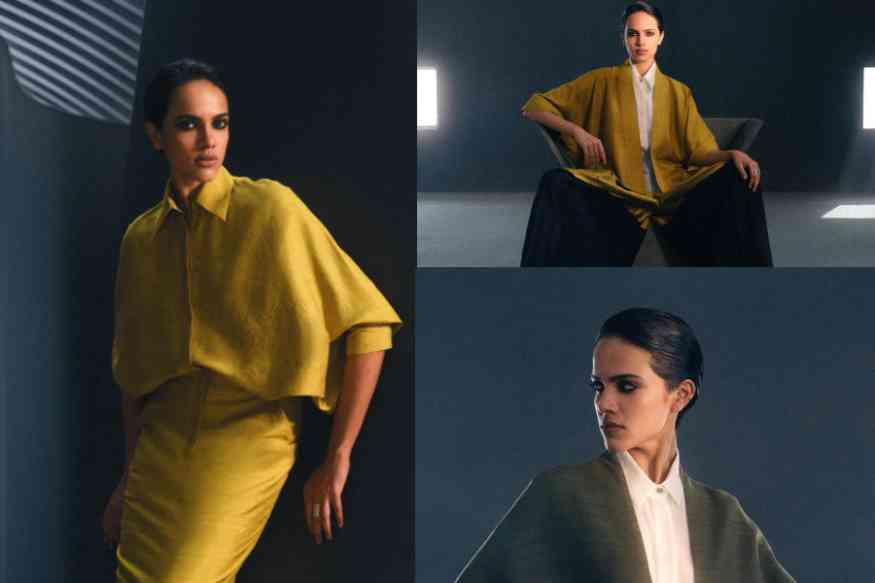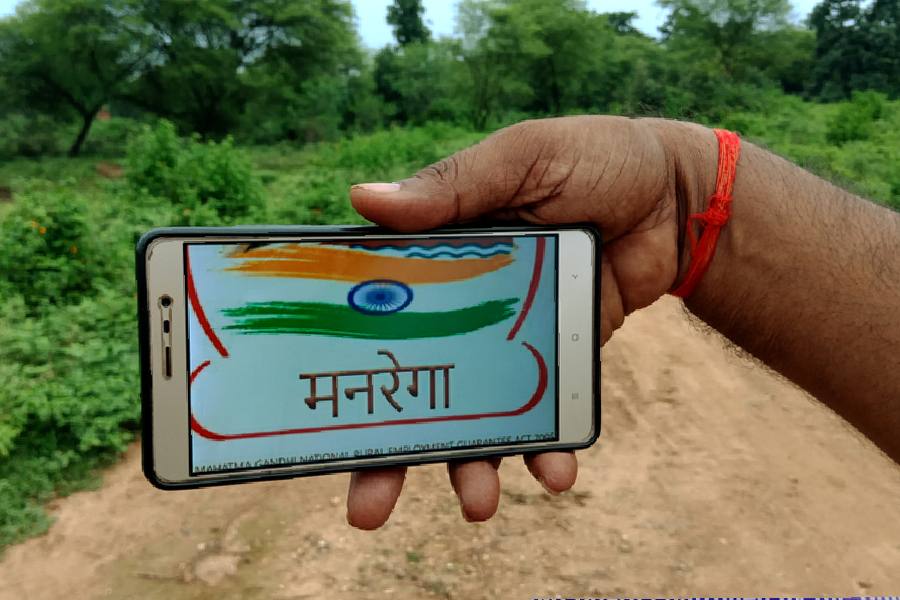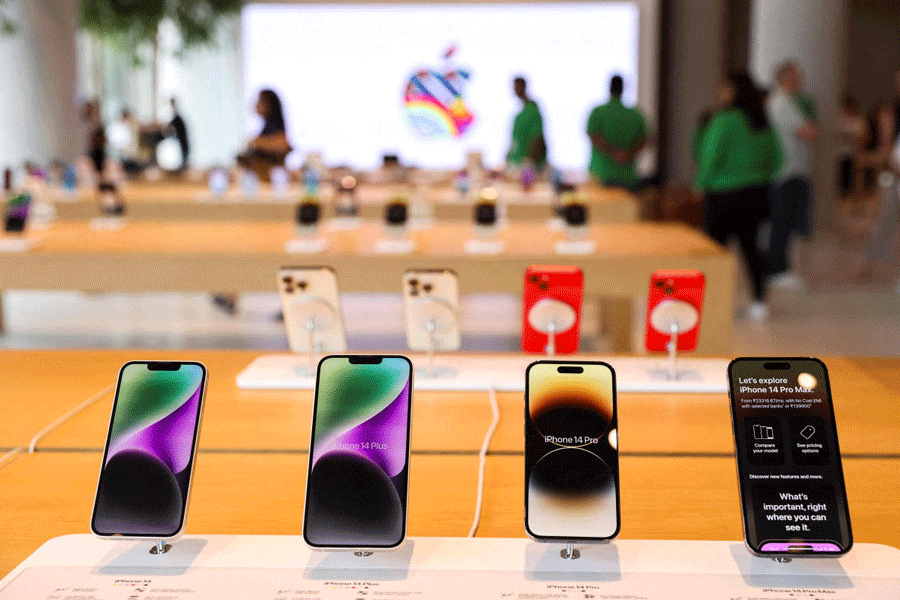We caught up with Payal Khandwala on a day when Calcutta felt like an active volcano. Her dulcet voice was an instant cooler. Much like her design ethos. Minimal yet statement, clutter-free, functional, built with the modern woman in mind. Payal’s clarity about what she wants to do was refreshing as was her sense of humour. In this chat with t2, Payal, who recently launched her latest collection, Release 13, looked back at her journey and her penchant for the stylish practical.
How has the 13-year-old journey been for you?
I was painting. I had studied it. I was doing that for a decade. So there wasn’t any plan. It wasn’t the usual, okay, graduated, studied fashion, which I had done, before I studied art. It wasn’t the obvious thing to do, because I guess then I didn’t know what I wanted to say with the clothes. I didn’t want to just make more clothes that look like other clothes.
I think we started the label because when I moved back from New York, and when I was painting, I couldn’t find any clothes that I wanted to wear. And so I was a bit confused. I really thought there was a vacuum... like easy separates, sort of system dressing, just real clothes for young women, real lives.
Given that culturally we have a coordinated system of dressing, like the salwar kameez-dupatta, the lehnga choli-dupatta, sari- blouse-petticoat. I think separates also wasn’t really a thing that I suppose people really wanted to do. Maybe some people are also a little bit nervous about it. Why do I have to make one more decision? Fair enough. But I think within that also, I thought it was important to give people a system of dressing so that, yes, you can buy 10 things, but you eventually will be comfortable enough to rotate those things, and you can do permutations and combinations so that you don’t look exactly the same. It’s not made to be worn exactly that same way. You can infuse it with your own self.
So when I started it, there was no plan to launch this big label. It was sort of a very impulsive decision, mostly out of this frustration, to be quite honest. I was like if no one else is going to make it, then I’ll make it.
I think that it really did strike a chord, and especially then, when there were even fewer people doing that. Now you see maybe a lot more of this sort of ‘India modern’ and separates and easy clothing and things. But I guess when we did it, we had that sort of first-mover (advantage). We kind of shifted the needle a bit. Since then it’s been kind of amazing, because it’s grown quite organically. We’ve done it on our own terms. You know, we don’t ever go on sale. We don’t really do large inventories. We do small drops. It’s a little slow and steady, which is kind of how I like it. And I think that, then, within the umbrella of the things that I care about, we try to do more, whether it was a print story, or whether it was getting our weaves done in Bengal, or whether it was Benaras, and, you know, all the things that I cared about.
I wore a brocade lehnga for my wedding, which was just a vintage lehnga. It only cost me ₹17,000. I added pockets to it. I had some textiles. I made a blouse. I had one other textile. I just threw the whole thing together, sort of good to go. It was sort of easy-breezy and comfortable. I didn’t have to carry a bag. I just put my lipstick in my pocket and my phone.
I think that then within the umbrella, we try to do lots of things that I just care about, whether it’s the brass accessories, the leather accessories, the home stuff. Mostly, it happens from a personal space. I’m trying to find something. I can’t find it. I’m like, okay, I’ve made the whole outfit, and all the bags in the world don’t work with my clothes. I’ll just make the bags. And then I was like, okay, what do I do with jewellery? I want something light and dramatic. There’s nothing there. So then I just made the jewellery. And then this home stuff. Why are my toothpicks in this ugly, plastic toothpick-holder? We were just trying to find beautiful things that made these everyday products have a nice home to live in. How can a bottle-opener be more beautiful so that you can leave it around and it looks like a beautiful piece of art?
I think we’ve sort of done that over the years. The thing that I’m most proud of is that in a world where, in any case, there’s just so much clutter and chaos and noise and everyone is screaming and shouting, we’ve been able to bring a little stillness. Everything’s done with care, and it’s a little bit quiet. I’m not really interested in a sort of short-term buzz kind of strategy. I prefer something that lingers, you know, something that’s timeless. So the clothes are timeless. I never cared about fashion ever. I worked in fashion when I was in New York, and I just was so disconnected from the whole scene. It’s quite an expensive hobby. I’m still supposed to be fashionable, and I was kind of broke. It just seemed so exhausting.
I just thought, why are women falling for this every day? Just doesn’t make any sense to me. And so I think that it has also helped us. I guess maybe because women designing for women, it gives you a sort of an added advantage, right? We understand the psychology. We’re so critical of ourselves. And, you know, what do we wear? What do I eat? How do I look? But I think we forget that the most important thing might be how you feel.
You don’t have to dress like men, but I thought it was time for people to just have an alternative, for the women that want it, because in the end, it’s subjective, and it’s fine. I wasn’t sure there were any women like that, but turns out there were.
Do you think your art background has also helped in how you look at clothes? Are your clothes also your canvas?
Yeah. Absolutely. Because I wasn’t so hung up about fashion, I think a lot of the things that I cared about when I was painting were the same things that I care about when I’m making the clothes. It’s just that it is a different canvas, because that was 2D and this 3D. This goes on a body, that goes on a wall.
I have no misconceptions that making clothes is making art. I mean, it is a creative journey, but it is a product first, right? Someone has to wear it, and then they have to be comfortable in it. They have to look good and feel good. And if you don’t tick these boxes, they’re not going to buy another one, right?
With art, it’s very different. You express something. You are on your own creative journey, you’ve made something. Somebody will respond to it, and I’ll respond to it, and it’s fine. They don’t have to wear it, they don’t have to live in it. They have to live with it, which is very different. I painted since I was little. My mom paints and her mom painted. So that was anyway in my DNA, I think, and because I was comfortable with colour, it’s the first thing people respond to in the clothes, the palette, because I have a certain degree of comfort. And then also just formal training on what you can do with what colour, how your brain responds to it, your emotional response to colours. It’s all like biology in the end.
Proportions are a big deal. That’s not something people, I think, respond to on the onset, but I think that once you wear the clothes, and other people respond to it, and they can tell how it changes how you look, right, because clothes have the power to make you look slimmer, taller, bigger, shorter, fatter, like it’s all about manipulating all these little things to cheat, so that you can just breathe and you can eat that extra toast.
I think the way I approach it is also very different because of my background in art, not just because, oh, I’m a creative person, but because there are a lot of overlapping formal elements that I’m constantly sort of preoccupied with, which I just transferred now to this discipline.
There’s a certain neatness too...
I’m a very irritating kind of neat person. Those nerdy kids in school who had neat handwriting. I am a bit of a perfectionist. It’s actually one of those things that I kind of struggle with, because my resting position is trying to perfect something. And when creative people sometimes get stuck, because you’re trying to create something perfect, we end up creating nothing at all, because you’re like, oh my God, that’s not going to be perfect, and that’s not how you should approach it. The idea is to try to achieve perfection, but to know that there is no such thing. And so you just try to do better. And you learn. Now I’m trying to sort of adopt the whole Japanese thing, it’s beautiful if it is a little bit flawed, right? I like things to be neat, because I do like things to be done with care, but if it’s woven by hand, and there is a slub somewhere, or there is an errant yarn that didn’t grab the dye as well as the one sitting next to it, that’s fine. I don’t consider that as a deal breaker. I feel that that’s what brings a little bit of personality to it, especially since we’re dealing with handlooms.
Your clothes are so versatile. This sense of exploration and being open to interpretations, does this also come from a sense of being an artist?
I do get bored easily. Especially now that I’m like, you know, 51 soon, I feel like there are some clothes that I keep gravitating towards, but I don’t want to wear them the same way every time. And I want to be able to wear that jacket with something else, or that trouser with something else. I want to be able to wear the shirt a certain way, buttoned up, buttoned down, sleeves up, sleeves down....
Textile has always been the hero...
We started with silks. We did have some linens. And then the next season, we started weaving our own silks. We already started weaving in Bengal and the season after that, we started our work in Benaras, and we’ve been doing it since. At the onset, only I knew that I wanted to also control the textile before I control the design of the garment.
We work in Phulia and we do some work in Bhagalpur. We do work with some factories in Bangalore as well. In Bengal and Benaras, we’ve got our own looms. So we have a little bit more control over these two, but we do source things from Bhagalpur as well.
Is it mostly hand-done?
All the things that you will probably see and respond to are all handwoven and some of the supporting acts, just to try to make it a little bit affordable and a little bit quicker... a little bit more flexibility on our end, they’ll do part handloom and part powerloom.
The Women of India series (photo books) is also an exploration into the feminine psyche...
For the label and for me, it’s always sort of been important to shift this narrative of what you perceive India as, and then it’s women, right? At least we know a little more than the guy sitting next to us.
Most of the people who buy our clothes outside of the country, and that is a large percentage, 80 per cent of those people are not Indians only to begin with. I feel a bit responsible, to also change the narrative of what people think of women in India and fashion from India. And it seems like it’s kind of pegged at this sort of maximalist, embellished, exuberant, accessorised, and, I mean, I don’t know, everybody doesn’t have so much jewellery, and I don’t have any of this jewellery. Great for people that have all these sorts of jewels that like you look royal, or, you can can cosplay a maharani or maharaja, and that’s fantastic. I just feel like, I don’t know that many people have that option, and so I want to be able to problem-solve for women. I don’t want them to feel bad that they don’t have this and they don’t have that, because I don’t think you need that much. You can make quite a difference if you just wear your personality and you work on that, and then you throw something on that complements it, then that’s enough.
And so to shine that spotlight on the women in India, and there are so many. Everybody sees women to be doing certain things and looking a certain way, but there are women quietly getting on with their lives, and I think that it’s important that, even in our own country, to be able to shine that light on these women’s lives and how diverse they can be, and then also in terms of outside of the country, to be able to champion that this isn’t the country you might think it is and women here are not necessarily doing what you think they’re doing, not just all dressing up and looking like a princess and going to weddings and choreographing dances. They’re doing other things. They’re horse-riding and they’re doctors and engineers and they’re climbing mountains and skateboarding. They’re doing everything. They’re doing everything everybody does anywhere else in the world as well.
Payal Kapadia wore an outfit of yours at Cannes...
She’s warm and humble. She couldn’t care less about fashion, and to be quite honest, that was lovely. It’s one more thing that she doesn’t want to be bothered by, or like, spend too much time thinking about. I mean, she’s going there as a director. I’m sure she’s got other priorities. She has to meet other producers, make sure she’s figuring out her next project, and I think the clothes have to be an accessory to all of that other stuff, and not the main act.
And she was lovely. She is very clear. She wants to be comfortable and can’t be fussed beyond a point. She wants to feel like herself, just a dressed-up version of herself, but she’s not going to be in a costume. She was exactly the kind of woman that we would like to dress.










